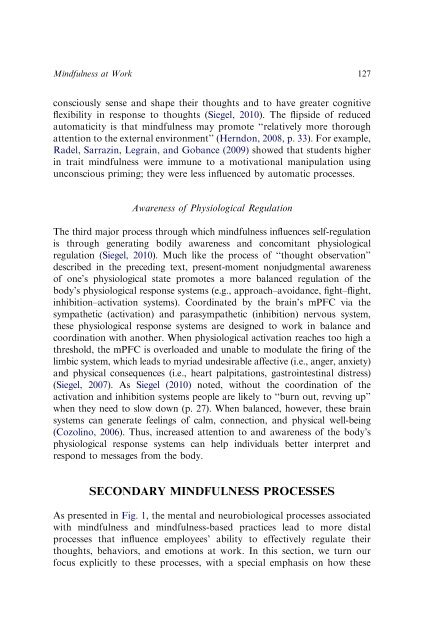Mindfulness at work (Glomb, Duffy et al, 2012) - Human Resources
Mindfulness at work (Glomb, Duffy et al, 2012) - Human Resources
Mindfulness at work (Glomb, Duffy et al, 2012) - Human Resources
Create successful ePaper yourself
Turn your PDF publications into a flip-book with our unique Google optimized e-Paper software.
<strong>Mindfulness</strong> <strong>at</strong> Work 127consciously sense and shape their thoughts and to have gre<strong>at</strong>er cognitiveflexibility in response to thoughts (Siegel, 2010). The flipside of reducedautom<strong>at</strong>icity is th<strong>at</strong> mindfulness may promote ‘‘rel<strong>at</strong>ively more thorough<strong>at</strong>tention to the extern<strong>al</strong> environment’’ (Herndon, 2008, p. 33). For example,Radel, Sarrazin, Legrain, and Gobance (2009) showed th<strong>at</strong> students higherin trait mindfulness were immune to a motiv<strong>at</strong>ion<strong>al</strong> manipul<strong>at</strong>ion usingunconscious priming; they were less influenced by autom<strong>at</strong>ic processes.Awareness of Physiologic<strong>al</strong> Regul<strong>at</strong>ionThe third major process through which mindfulness influences self-regul<strong>at</strong>ionis through gener<strong>at</strong>ing bodily awareness and concomitant physiologic<strong>al</strong>regul<strong>at</strong>ion (Siegel, 2010). Much like the process of ‘‘thought observ<strong>at</strong>ion’’described in the preceding text, present-moment nonjudgment<strong>al</strong> awarenessof one’s physiologic<strong>al</strong> st<strong>at</strong>e promotes a more b<strong>al</strong>anced regul<strong>at</strong>ion of thebody’s physiologic<strong>al</strong> response systems (e.g., approach–avoidance, fight–flight,inhibition–activ<strong>at</strong>ion systems). Coordin<strong>at</strong>ed by the brain’s mPFC via thesymp<strong>at</strong>h<strong>et</strong>ic (activ<strong>at</strong>ion) and parasymp<strong>at</strong>h<strong>et</strong>ic (inhibition) nervous system,these physiologic<strong>al</strong> response systems are designed to <strong>work</strong> in b<strong>al</strong>ance andcoordin<strong>at</strong>ion with another. When physiologic<strong>al</strong> activ<strong>at</strong>ion reaches too high <strong>at</strong>hreshold, the mPFC is overloaded and unable to modul<strong>at</strong>e the firing of thelimbic system, which leads to myriad undesirable affective (i.e., anger, anxi<strong>et</strong>y)and physic<strong>al</strong> consequences (i.e., heart p<strong>al</strong>pit<strong>at</strong>ions, gastrointestin<strong>al</strong> distress)(Siegel, 2007). As Siegel (2010) noted, without the coordin<strong>at</strong>ion of theactiv<strong>at</strong>ion and inhibition systems people are likely to ‘‘burn out, revving up’’when they need to slow down (p. 27). When b<strong>al</strong>anced, however, these brainsystems can gener<strong>at</strong>e feelings of c<strong>al</strong>m, connection, and physic<strong>al</strong> well-being(Cozolino, 2006). Thus, increased <strong>at</strong>tention to and awareness of the body’sphysiologic<strong>al</strong> response systems can help individu<strong>al</strong>s b<strong>et</strong>ter interpr<strong>et</strong> andrespond to messages from the body.SECONDARY MINDFULNESS PROCESSESAs presented in Fig. 1, the ment<strong>al</strong> and neurobiologic<strong>al</strong> processes associ<strong>at</strong>edwith mindfulness and mindfulness-based practices lead to more dist<strong>al</strong>processes th<strong>at</strong> influence employees’ ability to effectively regul<strong>at</strong>e theirthoughts, behaviors, and emotions <strong>at</strong> <strong>work</strong>. In this section, we turn ourfocus explicitly to these processes, with a speci<strong>al</strong> emphasis on how these


